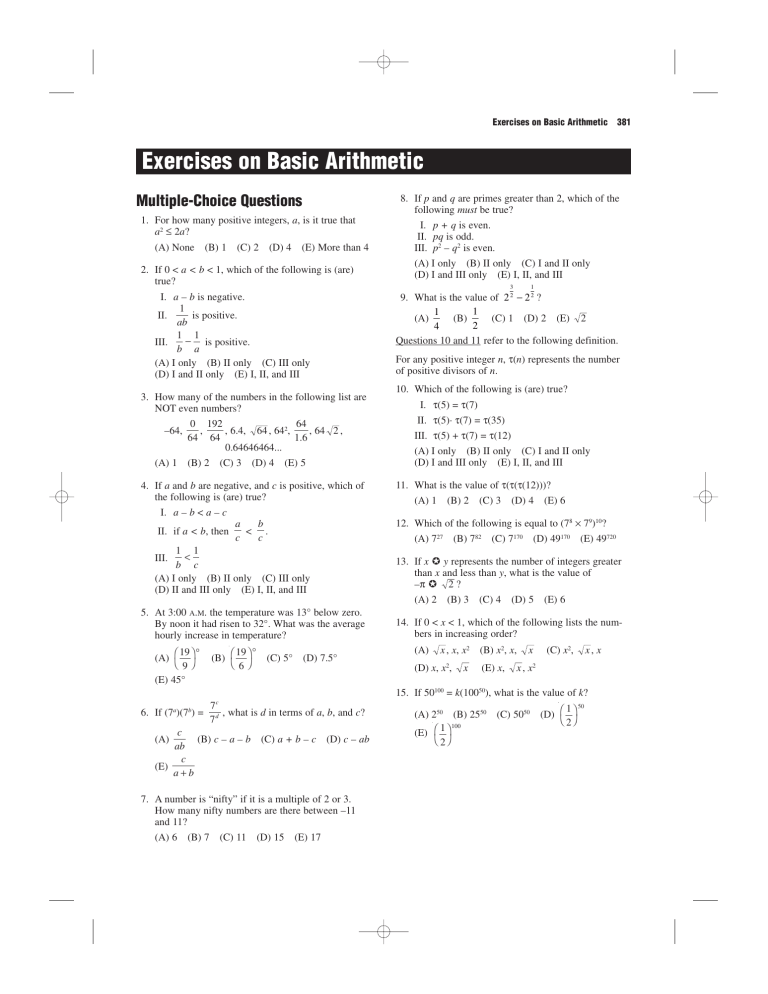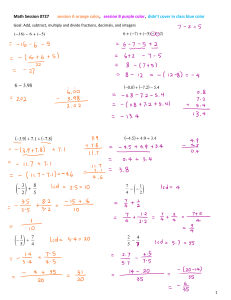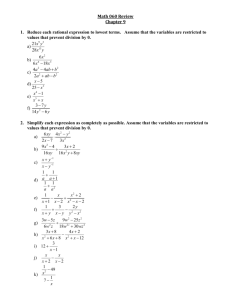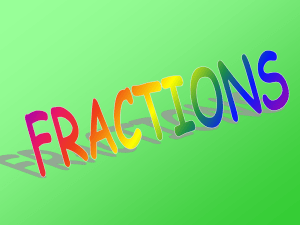
Exercises on Basic Arithmetic 381 Exercises on Basic Arithmetic Multiple-Choice Questions 1. For how many positive integers, a, is it true that a2 ≤ 2a? (A) None (B) 1 (C) 2 (D) 4 (E) More than 4 2. If 0 < a < b < 1, which of the following is (are) true? I. a – b is negative. 1 II. is positive. ab 1 1 − is positive. III. b a (A) I only (B) II only (C) III only (D) I and II only (E) I, II, and III 3. How many of the numbers in the following list are NOT even numbers? 0 192 64 , , 6.4, 64 , 642, , 64 2 , 64 64 1.6 0.64646464... (A) 1 (B) 2 (C) 3 (D) 4 (E) 5 –64, 4. If a and b are negative, and c is positive, which of the following is (are) true? I. a – b < a – c a b II. if a < b, then < . c c 1 1 < III. b c (A) I only (B) II only (C) III only (D) II and III only (E) I, II, and III 5. At 3:00 A.M. the temperature was 13° below zero. By noon it had risen to 32°. What was the average hourly increase in temperature? 19 ° (A) ⎛ ⎞ ⎝ 9⎠ 19 ° (B) ⎛ ⎞ ⎝ 6⎠ (C) 5° (D) 7.5° 8. If p and q are primes greater than 2, which of the following must be true? I. p + q is even. II. pq is odd. III. p2 – q2 is even. (A) I only (B) II only (C) I and II only (D) I and III only (E) I, II, and III 3 1 9. What is the value of 2 2 − 2 2 ? 1 1 (A) (B) (C) 1 (D) 2 (E) 2 2 4 Questions 10 and 11 refer to the following definition. For any positive integer n, τ(n) represents the number of positive divisors of n. 10. Which of the following is (are) true? I. τ(5) = τ(7) II. τ(5)· τ(7) = τ(35) III. τ(5) + τ(7) = τ(12) (A) I only (B) II only (C) I and II only (D) I and III only (E) I, II, and III 11. What is the value of τ(τ(τ(12)))? (A) 1 (B) 2 (C) 3 (D) 4 (E) 6 12. Which of the following is equal to (78 × 79)10? (A) 727 (B) 782 (C) 7170 (D) 49170 (E) 49720 13. If x y represents the number of integers greater than x and less than y, what is the value of –π 2 ? (A) 2 (B) 3 (C) 4 (D) 5 (E) 6 14. If 0 < x < 1, which of the following lists the numbers in increasing order? (A) x , x, x2 2 (D) x, x , x (B) x2, x, (E) x, x (C) x2, x, x 2 x, x (E) 45° 15. If 50100 = k(10050), what is the value of k? c 6. If (7a)(7b) = 7 , what is d in terms of a, b, and c? 7d c (B) c – a – b ab c (E) a+b (A) (C) a + b – c (D) c – ab 7. A number is “nifty” if it is a multiple of 2 or 3. How many nifty numbers are there between –11 and 11? (A) 6 (B) 7 (C) 11 (D) 15 (E) 17 (A) 250 (B) 2550 100 (E) ⎛ 1 ⎞ ⎝ 2⎠ (C) 5050 1 50 (D) ⎛ ⎞ ⎝ 2⎠ 382 Reviewing Mathematics 20. If x is an integer less than 1000 that has a remainder of 1 when it is divided by 2, 3, 4, 5, 6, or 7, what is one possible value of x? Grid-in Questions 16. If 25¢ buys 1.3 French francs, how many francs can be bought for $1.60? 17. At Ben’s Butcher Shop 99 pounds of chopped meat is being divided into packages each weighing 2.5 pounds. How many pounds of meat are left when there isn’t enough to make another whole package? 18. Maria has two electronic beepers. One of them beeps every 4 seconds; the other beeps every 9 seconds. If they are turned on at exactly the same time, how many times during the next hour will both beepers beep at the same time? 0 0 0 1 1 1 1 0 0 0 2 2 2 2 1 1 1 1 3 3 3 3 2 2 2 2 4 4 4 4 3 3 3 3 5 5 5 5 4 4 4 4 6 6 6 6 5 5 5 5 7 7 7 7 6 6 6 6 8 8 8 8 7 7 7 7 9 9 9 9 8 8 8 8 9 9 9 9 21. What is the value of 24 ÷ 2–4? 0 0 0 1 1 1 1 0 0 0 2 2 2 2 1 1 1 1 3 3 3 3 2 2 2 2 4 4 4 4 3 3 3 3 5 5 5 5 4 4 4 4 6 6 6 6 5 5 5 5 7 7 7 7 6 6 6 6 8 8 8 8 7 7 7 7 9 9 9 9 8 8 8 8 9 9 9 9 22. What is the value of |(–2 – 3) – (2 – 3)|? 0 0 0 1 1 1 1 2 2 2 2 0 0 0 3 3 3 3 1 1 1 1 4 4 4 4 2 2 2 2 5 5 5 5 3 3 3 3 6 6 6 6 4 4 4 4 7 7 7 7 5 5 5 5 8 8 8 8 6 6 6 6 9 9 9 9 7 7 7 7 8 8 8 8 9 9 9 9 19. If –7 ≤ x ≤ 7 and 0 ≤ y ≤ 12, what is the greatest possible value of y – x? 23. For any integer, a, greater than 1, let ↑a↓ be the greatest prime factor of a. What is ↑132↓? 0 0 0 1 1 1 1 2 2 2 2 0 0 0 3 3 3 3 1 1 1 1 4 4 4 4 2 2 2 2 5 5 5 5 3 3 3 3 6 6 6 6 4 4 4 4 7 7 7 7 5 5 5 5 8 8 8 8 6 6 6 6 9 9 9 9 7 7 7 7 8 8 8 8 9 9 9 9 Answer Key 383 24. If the product of four consecutive integers is equal to one of the integers, what is the largest possible value of one of the integers? 25. If x and y are positive integers, and (13x) y = 1313, what is the average (arithmetic mean) of x and y? 0 0 0 0 0 0 1 1 1 1 1 1 1 1 2 2 2 2 2 2 2 2 3 3 3 3 3 3 3 3 4 4 4 4 4 4 4 4 5 5 5 5 5 5 5 5 6 6 6 6 6 6 6 6 7 7 7 7 7 7 7 7 8 8 8 8 8 8 8 8 9 9 9 9 9 9 9 9 7. 8. 9. D E E Answer Key 1. 2. 3. 16. C D D 4. 5. 6. 8 . 3 2 17. 0 0 0 1 1 1 1 2 2 2 3 3 4 4 5 D C B 1 . 5 0 1 10. 11. 12. 18. 1 0 0 0 0 1 1 1 C C C 13. 14. 15. 19. 1 9 0 0 1 1 1 1 0 D B B 20. 4 2 1 0 0 0 1 1 1 1 2 2 2 2 2 2 2 2 2 2 2 2 2 2 3 3 3 3 3 3 3 3 3 3 3 3 3 3 3 4 4 4 4 4 4 4 4 4 4 4 4 4 4 4 5 5 5 5 5 5 5 5 5 5 5 5 5 5 5 6 6 6 6 6 6 6 6 6 6 6 6 6 6 6 6 7 7 7 7 7 7 7 7 7 7 7 7 7 7 7 8 8 8 8 8 8 8 8 8 8 8 8 8 8 9 9 9 9 9 9 9 9 9 9 9 9 9 9 9 0 2 3 3 4 4 5 5 5 6 6 6 6 7 7 7 7 7 8 8 8 8 8 9 9 9 9 or 841 21. 2 5 6 1 22. 4 23. 1 1 0 0 0 0 0 0 1 1 1 1 1 1 1 1 1 2 2 2 2 2 2 2 2 2 3 3 3 4 2 0 0 24. 3 0 25. 7 0 0 0 0 0 0 1 1 1 1 1 1 1 1 2 2 2 2 2 2 2 2 2 3 3 3 3 3 3 3 3 3 4 4 4 4 4 4 4 4 4 4 4 3 3 3 3 3 3 3 4 4 4 4 4 4 4 5 5 5 5 5 5 5 5 5 5 5 5 5 5 5 5 5 5 5 6 6 6 6 6 6 6 6 6 6 6 6 6 6 6 6 6 6 6 7 7 7 7 7 7 7 7 7 7 7 7 7 7 7 7 7 7 7 8 8 8 8 8 8 8 8 8 8 8 8 8 8 8 8 8 8 8 8 9 9 9 9 9 9 9 9 9 9 9 9 9 9 9 9 9 9 9 9 384 Reviewing Mathematics Answer Explanations 1. C. Since a is positive, divide both sides of the given inequality by a: a2 ≤ 2a ⇒ a ≤ 2 ⇒ a = 1 or 2. There are two positive integers that satisfy the given inequality. 2. D. Since a < b, a – b is negative. (I is true.) Since a and b are positive, so is their product, ab; and the reciprocal of a positive number is 1 1 a−b positive. (II is true.) − = . Since b a ab the numerator, a – b, is negative and the denominator, ab, is positive, the value of the fraction is negative. (III is false.) 3. D. Four numbers in the list are not even numbers: 6.4, 64 2 , and 0.64646464..., which are not 192 integers, and , which equals 3, an odd 64 integer. 4. D. Since b is negative and c is positive, b < c ⇒ –b > –c ⇒ a – b > a – c. (I is false.) Since c is positive, dividing by c preserves the inequality. (II is true.) Since b is 1 1 negative, is negative, and so is less than , b c which is positive. (III is true.) 5. C. In the 9 hours from 3:00 A.M. to noon, the temperature rose 32 – (–13) = 32 + 13 = 45°. Therefore, the average hourly increase was 45 ÷ 9 = 5°. 7c = 7c – d. Therefore: 7d a+b=c–d⇒a+b+d=c⇒ d = c – a – b. 6. B. (7a)(7b) = 7a+b , and 7. D. There are 15 “nifty” numbers between –11 and 11: 2, 3, 4, 6, 8, 9, 10, their opposites, and 0. 8. E. 9. E. All primes greater than 2 are odd, so p and q are odd, and p + q is even. (I is true.) The product of two odd numbers is odd. (II is true.) Since p and q are odd, so are their squares, and so the difference of the squares is even. (III is true.) 3 2 1 2 ( ) 2 −2 = 2 1 3 2 1 2 −2 = 8− 2 = 4 2− 2 =2 2− 2 = 2. 10. C. Since 5 and 7 have two positive factors each, τ(5) = τ(7). (I is true.) Since 35 has four divisors (1, 5, 7, and 35) and τ(5)· τ(7) = 2 × 2 = 4, II is true. The value of τ(12) is 6, which is not equal to 2 + 2. (III is false.) 11. C. τ(τ(τ(12))) = τ(τ(6)) = τ(4) = 3. 12. C. First, multiply inside the parentheses: 78 × 79 = 717; then raise to the 10th power: (717)10 = 7170. 13. D. There are five integers (1, 0, –1, –2, –3) that are greater than –3.14 (–π) and less than 1.41 ( 2). 14. B. For any number, x, between 0 and 1: x2 < x and x< x . 15. B. 50100 = k(10050) ⇒ (5050)( 5050) = k(250)(5050) ⇒ 50 50 k = 50 = 2550. 2 16. (8.32) You could set up a proportion (see Section 12-D): cents 25 160 = = , francs 1.3 x but the easiest way is to multiply by 4 to find that $1 buys 4 × 1.3 = 5.2 francs, and then multiply 5.2 × 1.60 = 8.32. 17. (1.5) Divide: 99 ÷ 2.5 = 39.6. The butchers can make 39 packages, weighing a total of 39 × 2.5 = 97.5 pounds, and have 99 – 97.5 = 1.5 pounds of meat left over. 18. (100) Since 36 is the LCM of 4 and 9, the beepers will beep together every 36 seconds. One hour = 60 minutes = 3600 seconds, and so the simultaneous beeping will occur 100 times. 19. (19) To make y – x as large as possible, let y be as large as possible (12), and subtract the smallest amount possible (x = –7): 12 – (–7) = 19. 20. (421 or 841) The LCM of 2, 3, 4, 5, 6, 7 is 420, so 420 is divisible by each of these integers, and there will be a remainder of 1 when 421 is divided by any of them. One more than any multiple of 420 will also work. 21. (256) 2 4 ÷ 2 −4 = 24 = 2 4−( −4 ) = 2 4+ 4 = 28 = 256 . 2 −4 22. (4) |(–2 – 3) – (2 – 3)| = |(–5) – (–1)| = |–5 + 1| = |–4| = 4. 23. (11) The easiest way to find the greatest prime factor of 132 is to find its prime factorization: 132 = 2 × 2 × 3 × 11, so 11 is the greatest prime factor. 132 66 2 6 2 11 3 12-B Fractions and Decimals 385 24. (3) If all four integers were negative, their product would be positive, and so could not equal one of them. If all four integers were positive, their product would be much greater than any of them (even 1 × 2 × 3 × 4 = 24). Therefore, the integers must include 0, in which case their product is 0. The largest set of four consecutive integers that includes 0 is 0, 1, 2, 3. 25. (7) Since 1313 = (13x) y = 13 xy , then xy = 13. The only positive integers whose product is 13 are 1 and 13. Their average is 1 + 13 = 7. 2 12-B FRACTIONS AND DECIMALS Several questions on the SAT involve fractions and/or decimals. In this section we will review all of the important facts on these topics that you need to know for the SAT. Even if you are using a calculator with fraction capabilities, it is essential that you review all of this material thoroughly. (See Chapter 1 for a discussion of calculators that can perform operations with fractions.) When a whole is divided into n equal parts, each part is 1 . For example, called one-nth of the whole, written as n if a pizza is cut (divided ) into eight equal slices, each ⎛ 1⎞ slice is one-eighth ⎝ ⎠ of the pizza; a day is divided into 8 ⎛ 1⎞ 24 equal hours, so an hour is one-twenty-fourth ⎝ ⎠ 24 ⎛ 1⎞ of a day; and an inch is one-twelfth ⎝ ⎠ of a foot. 12 • If Sam slept for 5 hours, he slept for five-twenty-fourths ⎛ 5⎞ ⎝ 24 ⎠ of a day. • If Tom bought eight slices of pizza, he bought eight⎛ 8⎞ eighths ⎝ ⎠ of a pie. 8 • If Joe’s shelf is 30 inches long, it measures thirty⎛ 30 ⎞ twelfths ⎝ ⎠ of a foot. 12 5 8 30 , , and , in which one 24 8 12 integer is written over a second integer, are called fractions. The center line is the fraction bar. The number above the bar is called the numerator, and the number below the bar is the denominator. Numbers such as CAUTION: The denominator of a fraction can never be 0. 5 , in which the numerator is less 24 than the denominator, is called a proper fraction. Its value is less than 1. 30 • A fraction such as , in which the numerator is more 12 than the denominator, is called an improper fraction. Its value is greater than 1. 8 • A fraction such as , in which the numerator and 8 denominator are the same, is also an improper fraction, but it is equal to 1. • A fraction such as It is useful to think of the fraction bar as a symbol for division. If three pizzas are divided equally among eight 3 people, each person gets of a pizza. If you actually 8 use your calculator to divide 3 by 8, you get 3 = 0.375. 8 Key Fact B1 Every fraction, proper or improper, can be expressed in decimal form (or as a whole number) by dividing the numerator by the denominator. For example: 3 = 0.3 10 8 =1 8 3 = 0.75 4 11 = 1.375 8 5 = 0.625 8 48 =3 16 3 = 0.1875 16 100 = 12.5 8 Note: Any number beginning with a decimal point can be written with a 0 to the left of the decimal point. In fact, some calculators will express 3 ÷ 8 as .375, whereas others will print 0.375. Calculator Shortcut On the SAT, never do long division to convert a fraction to a decimal. Use your calculator. Unlike the examples above, when most fractions are converted to decimals, the division does not terminate after two, three, or four decimal places; rather it goes on forever with some set of digits repeating itself. 2 = 0.666666... 3 3 5 = 0.272727... = 0.416666... 11 12 17 = 1.133333... 15 On the SAT, you do not need to be concerned with this repetition. On grid-in problems you just enter as much of the number as will fit in the grid; and on multiple-choice questions, all numbers written as decimals terminate. Although on the SAT you will have occasion to convert fractions to decimals (by dividing), you will not have to convert decimals to fractions.



